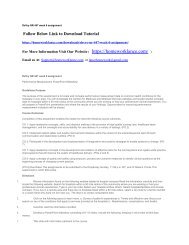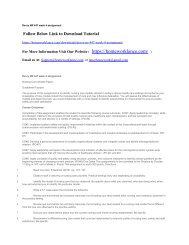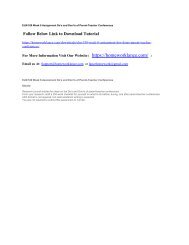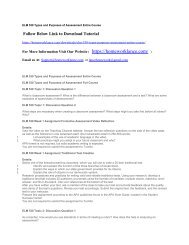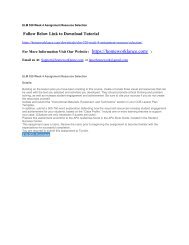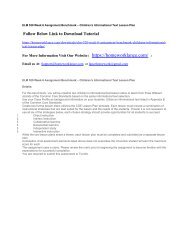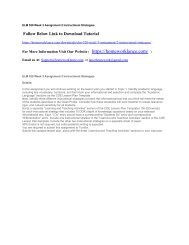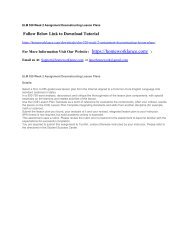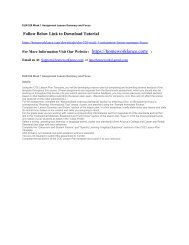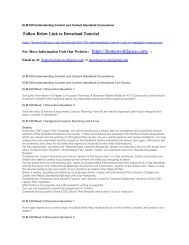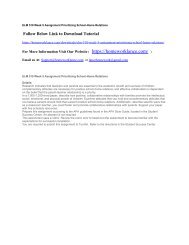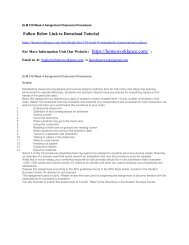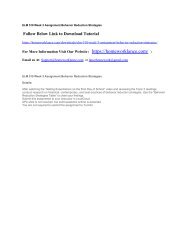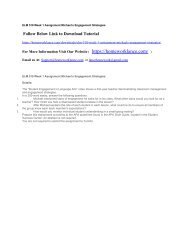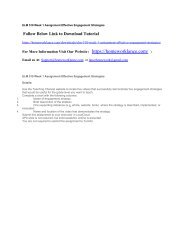ECON 201 Final Exam Answers
ECON 201 Final Exam Answers
ECON 201 Final Exam Answers
You also want an ePaper? Increase the reach of your titles
YUMPU automatically turns print PDFs into web optimized ePapers that Google loves.
<strong>ECON</strong> <strong>201</strong> <strong>Final</strong> <strong>Exam</strong> <strong>Answers</strong><br />
Follow Below Link to Download Tutorial<br />
https://homeworklance.com/downloads/econ-<strong>201</strong>-final-exam-answers-2/<br />
For More Information Visit Our Website ( https://homeworklance.com/ )<br />
Email us At: Support@homeworklance.com or lancehomework@gmail.com<br />
Question 1<br />
One defining characteristic of pure monopoly is that:<br />
A. The monopolist is a price taker<br />
B. The monopolist uses advertising<br />
C. . The monopolist produces a product with no close substitutes<br />
D. There is relatively easy entry into the industry, but exit is difficult<br />
Question 2<br />
Which is a barrier to entry?<br />
A. Close substitutes<br />
B. Diseconomies of scale<br />
C. Government licensing<br />
D. Price-taking behavior<br />
Question 3<br />
Other things equal, which reduces competition in an industry?<br />
A. Patent laws<br />
B. Freedom of entry for new firms<br />
C. An increase in the number of producers<br />
D. An increase in the number of buyers<br />
Question 4<br />
The representative firm in a purely competitive industry:<br />
A. Will always earn a profit in the short run<br />
B. May earn either an economic profit or a loss in the long run<br />
C. Will always earn an economic profit in the long run<br />
D. Will earn an economic profit of zero in the long run<br />
Question 5<br />
An example of a monopolistically competitive industry would be:
A. Steel<br />
B. Soybeans<br />
C. Electricity<br />
D. Retail clothing<br />
Question 6<br />
Firms in an industry will not earn long-run economic profits if:<br />
A. Fixed costs are zero<br />
B. The number of firms in the industry is fixed<br />
C. There is free entry and exit of firms in the industry<br />
D. Production costs for a given level of output are minimized<br />
Question 7<br />
Marginal product is:<br />
A. the increase in total output attributable to the employment of one more worker.<br />
B. the increase in total revenue attributable to the employment of one more worker.<br />
C. the increase in total cost attributable to the employment of one more worker.<br />
D. total product divided by the number of workers employed.<br />
Question 8<br />
The law of diminishing returns indicates that:<br />
A. as extra units of a variable resource are added to a fixed resource, marginal product will<br />
decline beyond some point.<br />
B. because of economies and diseconomies of scale a competitive firm’s long-run average total<br />
cost curve will be U-shaped.<br />
C. the demand for goods produced by purely competitive industries is down sloping.<br />
D. beyond some point the extra utility derived from additional units of a product will yield the<br />
consumer smaller and smaller extra amounts of satisfaction.<br />
Question 9<br />
Which of the following is most likely to be a variable cost?<br />
A. fuel and power payments<br />
B. interest on business loans<br />
C. rental payments on IBM equipment<br />
D. real estate taxes<br />
Question 10<br />
If average total cost is declining, then:
A. marginal cost must be greater than average total cost.<br />
B. the average fixed cost curve must lie above the average variable cost curve.<br />
C. marginal cost must be less than average total cost.<br />
D. total cost must also be declining.<br />
Question 11<br />
The selling of stock is debt financing for a corporation.<br />
o True<br />
o False<br />
Question 12<br />
Average fixed costs diminish continuously as output increases.<br />
o True<br />
o False<br />
Question 13<br />
Patents and copyrights were established by the government to reduce oligopoly and monopoly<br />
power.<br />
o True<br />
o False<br />
Question 14<br />
Prices in oligopolistic industries are predicted to fluctuate widely and frequently compared to<br />
other market structures.<br />
• True<br />
• False<br />
Question 15<br />
The positive view of advertising suggests that it contributes to economic efficiency in the<br />
economy.<br />
o True<br />
o False<br />
Question 16<br />
Price fixing is illegal under Section 1 of the Sherman Act.
o True<br />
o False<br />
Question 17<br />
Rent-seeking behavior refers to activities designed to transfer income or wealth to a particular<br />
firm or resource supplier at someone else’s or society’s expense.<br />
o True<br />
o False<br />
Question 18<br />
A purely competitive firm is a price maker, but a monopolist is a price taker.<br />
o True<br />
o False<br />
Question 19<br />
(Exhibit: Short-Run Costs) At the given price, the most profitable level of output occurs at<br />
quantity:<br />
A. N<br />
B. P<br />
C. S<br />
D. T<br />
Question 20<br />
(Exhibit: Short-Run Costs) If the price declines, the minimum quantity of output supplied in the<br />
short run is quantity:<br />
A. O.<br />
B. Q.<br />
C. R.<br />
D. S.<br />
Question 21<br />
(Exhibit: Short-Run Costs) If the price declines, production will continue in the short run, even<br />
though the firm incurs a loss, between quantities:
A. and Q.<br />
B. Q and R.<br />
C. R and S.<br />
D. S and T.<br />
Question 22<br />
(Exhibit: Short-Run Costs) This firm’s supply curve begins at quantity:<br />
A. Q.<br />
B. R.<br />
C. S.<br />
D. T.<br />
Question 23<br />
(Exhibit: Profit Maximization in Monopolistic Competition) A firm in monopolistic competition<br />
will maximize profits by producing the level of output where:<br />
a. P = MC<br />
b. MR = MC<br />
c. P = MR<br />
d. price minus ATC (i.e., economic profit per unit) is the largest.<br />
Question 24<br />
(Exhibit: Profit Maximization in Monopolistic Competition) In the short run, a firm in<br />
monopolistic competition may experience economic profits as shown in Panel (a) as the distance:<br />
a. PS.<br />
b. PS times the quantity 0M.<br />
c. PS times the quantity Q.<br />
d. PT times the quantity Q.<br />
Question 25<br />
(Exhibit: Profit Maximization in Monopolistic Competition) If other firms see economic profits<br />
in the industry, they will enter it, and the demand curve for firms already in the industry will shift<br />
to the ________ ; in the long run, this will result in economic profit _______ and price _______ .
a. right; = 0; = ATC; = minimum ATC<br />
b. right; > 0; > ATC<br />
c. left; < 0; < ATC d. left; = 0; = ATC; > minimum ATC<br />
Question 26<br />
(Exhibit: Profit Maximization in Monopolistic Competition) In monopolistic competition, longrun<br />
equilibrium is characterized by:<br />
a. P > MR.<br />
b. P < MR. c. P = MR. d. profit maximization, which occurs where P = MR = MC. Question 27<br />
(Exhibit: Profit Maximization in Monopolistic Competition) In Panel (a), if the firm raises its<br />
price above P, it will:<br />
a. lose all its customers.<br />
b. still have some customers.<br />
c. not lose any customers.<br />
d. have none of the above occur.<br />
Question 28<br />
(Exhibit: Profit Maximization in Monopolistic Competition) In determining the price in<br />
monopolistic competition:<br />
a. the price to the firm is given by supply and demand for the industry.<br />
b. the firm is a price taker.<br />
c. the firm applies the marginal decision rule.<br />
d. A and B are true.<br />
Question 29<br />
Which of the following is (are) most likely to be produced under conditions resembling perfect<br />
competition – automobiles, beer, corn, diamonds, and eggs. Defend your answer in economic<br />
terms.



